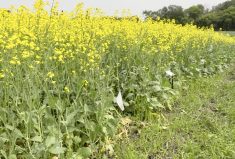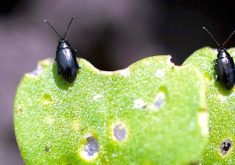There’s much we don’t know and may never know in the so-called Triffid Affair that has devastated Canada’s flax industry in the past month.
In fact, all we do know about this development so far is that buyers in Canada’s most important flax market believe they have identified small quantities of the genetically modified variety CDC Triffid in at least two shipments. We also know that this belief has had a depressing effect on the market.
The presence of CDC Triffid can’t be confirmed until the samples showing the genetic marker implicated in this discovery can be compared with actual samples of the variety. Even then, some who are knowledgeable about this issue doubt an absolutely conclusive match can be made.
Read Also

Manitoba sclerotinia picture mixed for 2025
Variations in weather and crop development in this year’s Manitoba canola fields make blanket sclerotinia outlooks hard to pin down
It is also doubtful that if there are “culprits” in this scenario – people who consciously decided to continue producing and marketing genetically modified flaxseed after the industry voluntarily chose not to – that they will ever be caught. And even if they are, it is unlikely that they did anything illegal, provided they were growing a variety containing the GM “event” that went through the federal government’s Plant with Novel Traits assessment for food, feed and environmental release.
Growing an unregistered variety such as CDC Triffid is not illegal in Canada, although it cannot be sold by variety name and it is supposed to be marketed into the lowest grade category for the crop. But as the proportion of farm-saved flaxseed on the Prairies is even more common than farm-saved wheat, it is highly possible that commercial growers were unaware they were even producing it.
Despite all these unknowns, it is clear that the flax industry’s concern that led to its decision to voluntarily withdraw CDC Triffid from the system and deregister the variety in 2001 was justified. It would have been more effective had that decision been made before the variety was approved in 1998. But in the end, the industry collectively – or so it was thought at the time – determined that the perceived benefits of having a flax variety that had improved tolerance to herbicide residues were not worth the market risk.
The varietal registration system in Canada is not designed to take potential market impacts into account. But this serves as a reminder that delivering something the market doesn’t want – even in minute quantities – can have expensive repercussions.
The establishment of acceptable international tolerance limits would have prevented this from becoming an issue. But this customer is not ready to accept any amount of genetically modified material. In this case, the only acceptable tolerance is zero, which Canada can apparently no longer achieve.
In the wake of this, there are discussions about steps the industry must take to ensure this doesn’t happen again, several of which imply the end of farmer-saved seed. This is already a reality in other crops. For example, in order to capture the benefits of hybridization, more effective seed treatments and herbicide-tolerant traits, the vast majority of farmers has willingly adapted to the cost of purchasing canola seed each year.
In wheat, the elimination of kernel visual distinguishability (KVD) has made it necessary for farmers to declare the variety of wheat they are growing upon delivery. Like it or not, assurances of that variety can only be achieved by using certified seed.
With flax, it may now be the only way to regain the confidence of key markets.
Perhaps the biggest wake-up call emerging from the Triffid Affair is not so much a cautionary tale about growing unregistered varieties – but a recognition that farming for export requires co-operation in a business that has been cultured in rugged individualism.
Despite the industry buzz around the concepts of identity preservation, traceability, and value chains, the reality remains that the majority of Canada’s export business is in the form of bulk, commingled shipments. The efforts of dozens to hundreds of farmers go into the cargo hold of a trans-ocean vessel. Its integrity is tied to decisions made by these individuals and their commitment to maintaining Canada’s reputation.
The value-added component of this relates to the system’s ability to guarantee buyers they are getting what our exporters say they are getting, and on a consistent basis. Canada has historically staked its reputation on its quality control and assurance system. The federal government’s recent move to develop the Canada Brand is a reflection of this ongoing commitment.
But it’s a commitment that only works when individuals choose to comply because they recognize their own self-interest best served by co-operating towards a common goal. The decision of whether to operate according to the rules shouldn’t be based on your risk of being caught if you don’t. When it comes right down to it, the Canada Brand is you. [email protected]


















